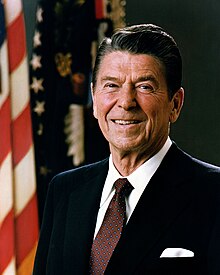Search This Blog
Sunday, April 15, 2012
Ronald Reagan
Served as President from 1981-1989
Era: The Conservative Resurgence
American Identity and Culture
During Reagan’s presidency, an era of conservatism reemerged. A loose coalition of economic and political conservatives, religious fundamentalists, and political action committees (PACs) rose. These groups opposed big government, new Deal liberalism, gun control, feminism, gay rights, welfare, affirmative action, sexual permissiveness, abortion, and drug use. They saw these issues as the cause of the decline in family and religious values, work ethic, and national security. Three best-selling novels written by Tom Clancy portray the Reagan Era: The Hunt for Red October (1984), Red Storm Rising (1986), and The Cardinal of the Kremlin (1988). They reflect values from the Cold War and were used to ideas of national security to the public.
Economic Transformations and Globalization
Regan emphasized supply-side economics (also known as “Reaganomics”) which argued that tax cuts reduced government spending, increased investment, and led to increased production, jobs, and prosperity. Congress passed most of the tax cuts suggested by Reagan which included a twenty five percent decrease in personal income taxes over three years. There were also cuts in the corporate income tax, capital gains tax, and gift and inheritance taxes. The top income tax rate was reduced to twenty eight percent. Republicans cut over $40 billion from domestic programs, which included food stamps, student loans, and mass transportation. However, the savings allowed a dramatic increase in military spending in its place.
Environment
The Reagan administration followed up on its promise of “getting government off the backs of the people” by reducing federal government regulation on business and industry (deregulation). This also meant that the government eased up its restriction on issues like environmental protection. For example, to help America’s struggling auto industry, regulations on emissions and auto safety were reduced. Secretary of the Interior James Watt also opened federal lands to increase coal and timber production and offshore waters for oil drilling.
Politics and Citizenship
The Reagan administration’s conservative agenda called for a stronger military, lower taxes, fewer social programs, and traditional cultural values. This helped the Republicans to become the majority party. In his approach to combating the Cold War, Reagan increased spending for defense and aid to anticommunist forces in Latin America. For example, his administration increased spending on the Strategic Defense Initiative (SDI) which was a plan for building a high-tech system of lasers and particle beams to destroy enemy missiles before they could reach U.S. territory. This shows that Reagan’s political focus were on conservative goals and the Cold War.
Slavery and its legacies in North America
During years of recession, white males blamed their problems on “reverse discrimination” due to the government’s support of racial and ethnic quotas. An example of this was the Supreme Court case of Bakke v. Regents of the University of California (1978) where Allan Bakke, a white male, sued saying that he was excluded from admission solely on the basis of race. The Supreme Court upheld the university’s use of race in its admissions decisions, but it also found that Bakke should have been admitted and banned the use of racial quotas alone. After this event, conservatives worked even harder to end preferential treatment based on racial and ethnic backgrounds.
War and Diplomacy
In 1985, Mikhail Gorbachev became the new Soviet leader and introduced two major reforms: glasnost (openness) to end political repression and perestroika, or restructuring of the economy by introducing some free-market tactics. In order to achieve his reforms, Gorbachev needed to end the costly arms race. As a result, in 1987, Gorbachev and Reagan agreed to remove and destroy all intermediate-range missiles (the INF agreement). To further reduce Cold War tensions, Gorbachev removed Soviet troops from Afghanistan and even cooperated with the United States in pressuring Iran and Iraq to end their war. Relations had improved so much that the end of the Cold War seemed close.
Subscribe to:
Post Comments (Atom)

No comments:
Post a Comment